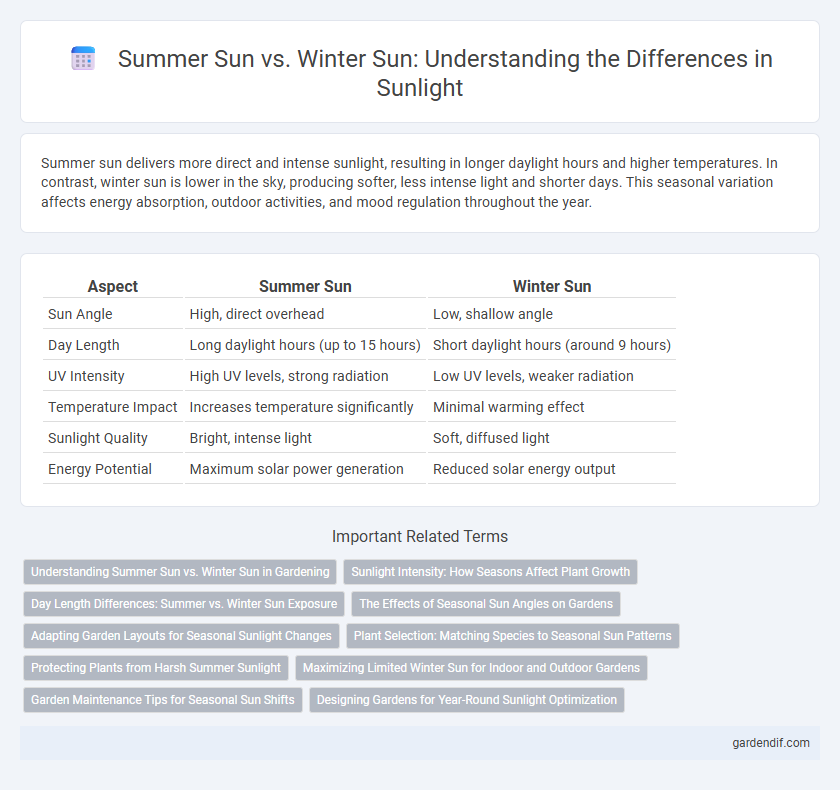
Summer sun vs winter sun Illustration
Summer sun delivers more direct and intense sunlight, resulting in longer daylight hours and higher temperatures. In contrast, winter sun is lower in the sky, producing softer, less intense light and shorter days. This seasonal variation affects energy absorption, outdoor activities, and mood regulation throughout the year.
Table of Comparison
| Aspect | Summer Sun | Winter Sun |
|---|---|---|
| Sun Angle | High, direct overhead | Low, shallow angle |
| Day Length | Long daylight hours (up to 15 hours) | Short daylight hours (around 9 hours) |
| UV Intensity | High UV levels, strong radiation | Low UV levels, weaker radiation |
| Temperature Impact | Increases temperature significantly | Minimal warming effect |
| Sunlight Quality | Bright, intense light | Soft, diffused light |
| Energy Potential | Maximum solar power generation | Reduced solar energy output |
Understanding Summer Sun vs. Winter Sun in Gardening
Summer sun delivers intense, direct light with longer daylight hours, promoting robust photosynthesis and faster growth in sun-loving plants. In contrast, winter sun offers lower intensity and shorter duration, requiring gardeners to select shade-tolerant or cold-hardy species that thrive under reduced light conditions. Understanding these seasonal sunlight variations enables optimized planting strategies and improves overall garden health.
Sunlight Intensity: How Seasons Affect Plant Growth
Sunlight intensity varies significantly between summer and winter, directly impacting plant growth cycles and photosynthesis rates. During summer, higher solar elevation and longer daylight hours increase sunlight intensity, promoting robust photosynthetic activity and accelerated plant development. In contrast, winter sunlight decreases in intensity due to lower solar angles and shorter days, slowing growth and reducing overall plant productivity.
Day Length Differences: Summer vs. Winter Sun Exposure
Summer sun provides significantly longer day lengths, offering up to 16 hours of sunlight in many temperate regions, compared to the winter sun's mere 8 to 10 hours. The extended daylight during summer enhances natural vitamin D synthesis and boosts mood through increased serotonin production. In contrast, shorter winter days result in reduced sun exposure, often leading to lower energy levels and seasonal affective disorder (SAD) risks.
The Effects of Seasonal Sun Angles on Gardens
The seasonal sun angles dramatically affect garden growth by altering the intensity and duration of sunlight exposure. Summer sun, positioned higher in the sky, delivers more direct and prolonged light, promoting vigorous photosynthesis and rapid plant development. Winter sun, lower and less intense, results in shorter daylight hours and cooler temperatures, which can slow plant growth and influence species selection for garden resilience.
Adapting Garden Layouts for Seasonal Sunlight Changes
Summer sun delivers intense, direct rays that require strategic placement of heat-sensitive plants in shaded or north-facing garden areas to prevent scorching. Winter sun angles lower, providing softer light that benefits sun-loving species when positioned in south-facing locations to maximize warmth and growth. Adjusting garden layouts seasonally ensures optimal sunlight exposure, promoting plant health and vibrant blooms year-round.
Plant Selection: Matching Species to Seasonal Sun Patterns
Summer sun typically delivers intense, direct light with prolonged daylight hours, favoring heat-tolerant, sun-loving plants such as succulents, lavender, and tomatoes. Winter sun provides lower intensity and shorter duration of sunlight, making it ideal for shade-tolerant or cold-hardy species like pansies, kale, and cyclamen. Selecting plant species based on these seasonal sun patterns ensures optimal growth, flower production, and overall plant health by aligning botanical needs with natural sunlight availability.
Protecting Plants from Harsh Summer Sunlight
Summer sun delivers intense ultraviolet rays and higher temperatures that can scorch plant leaves, leading to dehydration and stunted growth. Implementing shade cloths, applying mulch to retain soil moisture, and providing adequate watering during peak sunlight hours effectively protect plants from harsh summer sunlight. Winter sun offers gentler light and lower heat, generally posing less risk to plant health compared to the damaging effects of summer exposure.
Maximizing Limited Winter Sun for Indoor and Outdoor Gardens
Winter sun provides lower angles and shorter daylight hours compared to summer sun, requiring strategic placement of indoor and outdoor gardens for optimal light exposure. Utilizing south-facing windows, reflective surfaces, and light shelves maximizes natural sunlight capture, enhancing photosynthesis during colder months. Selecting shade-tolerant plants and employing supplemental grow lights further improves growth efficiency when sunlight availability is limited.
Garden Maintenance Tips for Seasonal Sun Shifts
Summer sun delivers intense, direct rays that accelerate plant growth and increase water evaporation, requiring frequent irrigation and shading strategies to protect delicate foliage. Winter sun provides lower-angle, softer light that reduces heat stress but limits photosynthesis, necessitating pruning to maximize light exposure and mulch application to retain soil warmth. Adjusting watering schedules, optimizing plant placement, and selecting sun-tolerant species help maintain garden health during these seasonal sun shifts.
Designing Gardens for Year-Round Sunlight Optimization
Designing gardens for year-round sunlight optimization requires understanding the distinct angles and intensity of summer sun versus winter sun. Summer sun is higher in the sky, providing intense, direct light that can stress plants if not properly managed with shade structures or heat-tolerant species. Winter sun, positioned lower and less intense, offers valuable warmth and light during colder months, making strategic placement of deciduous trees and south-facing elements essential for maximizing solar gain throughout the year.
Summer sun vs winter sun Infographic

 gardendif.com
gardendif.com